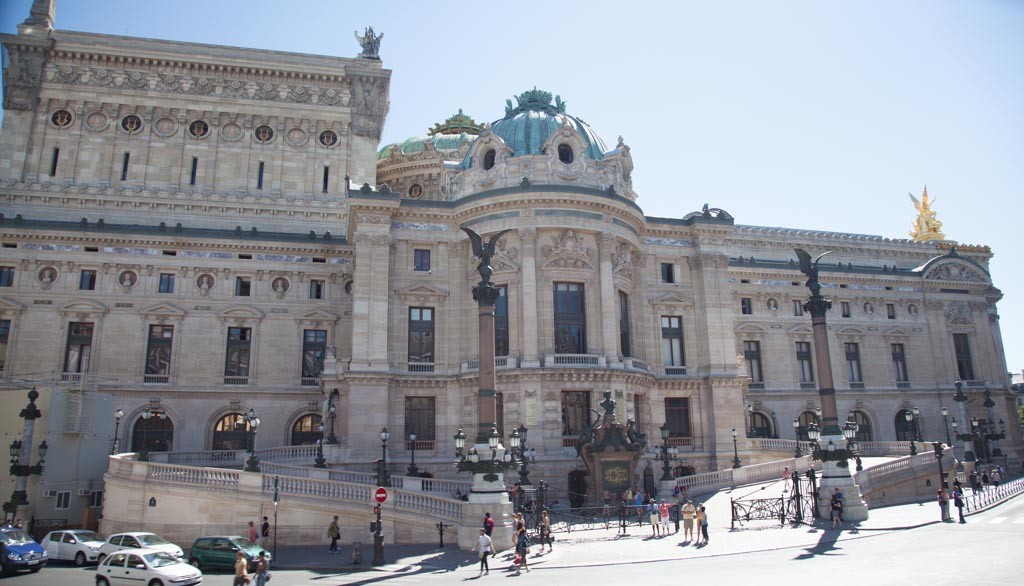 So when my sister said we just had to see the Opera House it was met with a tepid response…none of us being opera fans. We went anyway. And if we had worn socks that day they would have been blown off. What a remarkable building. The building, commissioned by Napoleon III, was designed by a 35-year-old unknown architect, Charles Garnier. The place is jaw-droppingly spectacular from the first moment you set eyes on it. The picture above shows the street entrance where “les abonnées” would be dropped off by their carriage drivers. The front entrance, where Paris’ “less-than-wealthy” people show up…they are not treated to the same experience. Firstly, the subscribers have their own vestibule and hallway for them to linger and chat as they arrive and hang up their furs.
So when my sister said we just had to see the Opera House it was met with a tepid response…none of us being opera fans. We went anyway. And if we had worn socks that day they would have been blown off. What a remarkable building. The building, commissioned by Napoleon III, was designed by a 35-year-old unknown architect, Charles Garnier. The place is jaw-droppingly spectacular from the first moment you set eyes on it. The picture above shows the street entrance where “les abonnées” would be dropped off by their carriage drivers. The front entrance, where Paris’ “less-than-wealthy” people show up…they are not treated to the same experience. Firstly, the subscribers have their own vestibule and hallway for them to linger and chat as they arrive and hang up their furs.
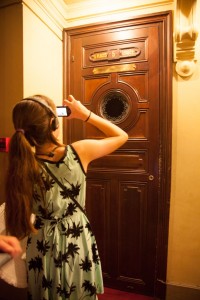 They also have their own loges, with its private entrance, from which they can take in the opera, watch Debussy perform his latest work or chat about Berlioz’ last revue of Ravel`s performance the week before. All the loges have velvet lining and a small velvet-covered wall for privacy so that guests can concentrate on the performance and not what Madame next door is wearing. But beware of Erik whose face, legend has it, was horribly disfigured in a fire shortly before the Opera House was built (his fiancée perished in the blaze). He roamed the bowels of the Opera, eventually helping train a young singer. They say his ghost roams the hallways and they still reserve Loge numéro 5 for him.
They also have their own loges, with its private entrance, from which they can take in the opera, watch Debussy perform his latest work or chat about Berlioz’ last revue of Ravel`s performance the week before. All the loges have velvet lining and a small velvet-covered wall for privacy so that guests can concentrate on the performance and not what Madame next door is wearing. But beware of Erik whose face, legend has it, was horribly disfigured in a fire shortly before the Opera House was built (his fiancée perished in the blaze). He roamed the bowels of the Opera, eventually helping train a young singer. They say his ghost roams the hallways and they still reserve Loge numéro 5 for him.
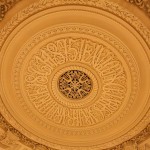
But back to the building…one of the first things the audio-guide mentions is the architect`s subtle “signature”… an ornate ceiling decoration that, at first glance, looks like pretty squiggly things. In reality, he has signed his name there, and the year of construction. Click on the photo and see if you can spot the signature. Apparently, there’s an errant letter E there that some conspiracy theorists insist is an accommodation for Erik, the Phantom of the Opera.
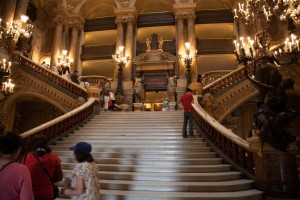 Further up leads to more marvels. The stairway designed by Garnier is composed of marble imported from Italy, parts of Africa and Scandinavia. He chose white marble for the stairs because, in his words, they make the beautiful women stand out and highlight their wonderful gowns. The balustrade is composed of four different marbles. This is no typical government project awarded to the lowest bidder with a bunch of chainsaw-wielding contractors putting up a frame. Garnier choose to build with a steel frame (his good friend, Gustave Eiffel was inspired to use steel for his next project) then cover it with plaster, marble and velvet. The result is opulent and actually made me check out the schedule to see if there was an opera we could attend while here.
Further up leads to more marvels. The stairway designed by Garnier is composed of marble imported from Italy, parts of Africa and Scandinavia. He chose white marble for the stairs because, in his words, they make the beautiful women stand out and highlight their wonderful gowns. The balustrade is composed of four different marbles. This is no typical government project awarded to the lowest bidder with a bunch of chainsaw-wielding contractors putting up a frame. Garnier choose to build with a steel frame (his good friend, Gustave Eiffel was inspired to use steel for his next project) then cover it with plaster, marble and velvet. The result is opulent and actually made me check out the schedule to see if there was an opera we could attend while here.
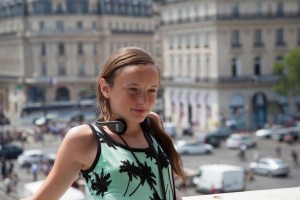
I could go on for ever about this place. The artwork (Chagal painted the ceiling in the main auditorium), the woodwork, the sculptures and the overwhelming ambiance of luxury and pomposity that permeates this grand place…you can almost see the ghosts of Paris of the late 19th century chatting in the Grand Hall during the entr’acte, discussing the social scene of the day.
From the Opera Charles Garnier, we had a quick lunch (by “quick” I mean “expensive” — 50 euros is typical for 4 baguettes and beverages — beer is the same price as coke, so you can guess what quenched my thirst).

Then we’re off to l’Église de la Madeleine — a building originally designed by Napoleon I as a masonic temple dedicated to his Grande Armée in 1806, was transformed into a train station then, in 1845, became a Roman Catholic church. It looks like a Roman temple, with its 52 Corinthian columns, and stands high above the ground with three sets of steps to get to the enormous carved doors. This is a working church and as we stepped into the immense interior, with its 14 confessionals and 7 altars, we hear a choral rehearsing. The effect is, of course, both hair-raising and relaxing. The acoustics are amazing in spite of its high ceilings and lack of windows. It`s hard to imagine a church this grand, these days, having enough devotees to be able to finance its upkeep.
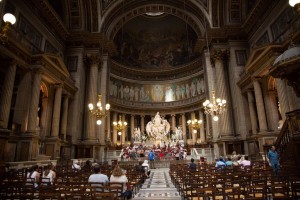
Not surprisingly, a poster announces several upcoming concerts in the church. Vivaldi, Beethoven and others. We gawk for quite awhile, then we sit in one of the benches and take in the atmosphere as the choir sings on. After a brief rest and respite from the sun, we head out down rue Royale towards Place de la Concorde. We pass by shops selling crystal, where a single crystal shot glass sells for 135€ and an unremarkable vase sells for 2,200€…I can`t even imagine what the crystal chandelier goes for.

Place de la Concorde is the central courtyard of the Royal Court. This is where Marie Antoinette lost the need to pick out which wig to wear. Beautiful fountains frame each side of the central part of the square and a large Roman obelisk sits in the middle. Most of it is inaccessible at the moment as Paris prepares for Bastille Day celebrations … a large stand sits between the fountains and more stands line both sides of les Champs Élysées. We strolled the Champs Élysées, Erin and I, in 1999 on our honeymoon and I recall the parklands of the Champs Élysées being more lush and green (and somewhat less busy). Perhaps this is a result of the current heat wave, perhaps more a sign of global climate change.
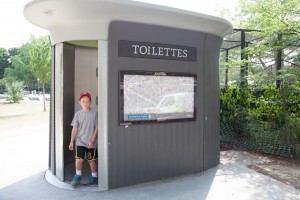 As is likely to occur, rehydrating frequently has a predictable side effect. And as we hunted for a public restroom we found that all of the former “old school” public toilets on Champs Élysées had been shuttered. Then we came upon this contraption. There was a lineup so we queued and waited and finally the door slid open and a woman walked out. The man at the head of the line didn`t budge. “What’s he doing?” Erin asked, somewhat urgently. “Pardon monsieur,” I ask, pointing to the open door which is now sliding closed. “It must be cleaned, monsieur,” he answers, as if it was obvious. Suddenly I hear the sound of water rushing as if from a hose, the building (which looks like it was created by Rubbermaid) shudders a bit then I hear the whoosh of a dryer. Then the doors open, a red light turns green, and in walks the next client. A sign on the control panel explains the operation of the unit — we quickly learn that a 2 minute process has been transformed into a 10 minute ordeal for the sake of cleanliness. My first thought is that this is a public toilet designed by a committee of French bureaucrats and German engineers.
As is likely to occur, rehydrating frequently has a predictable side effect. And as we hunted for a public restroom we found that all of the former “old school” public toilets on Champs Élysées had been shuttered. Then we came upon this contraption. There was a lineup so we queued and waited and finally the door slid open and a woman walked out. The man at the head of the line didn`t budge. “What’s he doing?” Erin asked, somewhat urgently. “Pardon monsieur,” I ask, pointing to the open door which is now sliding closed. “It must be cleaned, monsieur,” he answers, as if it was obvious. Suddenly I hear the sound of water rushing as if from a hose, the building (which looks like it was created by Rubbermaid) shudders a bit then I hear the whoosh of a dryer. Then the doors open, a red light turns green, and in walks the next client. A sign on the control panel explains the operation of the unit — we quickly learn that a 2 minute process has been transformed into a 10 minute ordeal for the sake of cleanliness. My first thought is that this is a public toilet designed by a committee of French bureaucrats and German engineers.
Our exploits end after a quick bite at one of the patios on the Champs Élysées, a quick trip to FNAC to buy our tickets to the Louvre for tomorrow and a short Métro ride home. We’re starting to get used to the 38º weather.